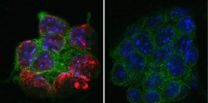(Press-News.org) CINCINNATI—Researchers at the University of Cincinnati (UC) and Cincinnati Children's Hospital Medical Center have found a new genetic mutation responsible for deafness and hearing loss associated with Usher syndrome type 1.
These findings, published in the Sept. 30 advance online edition of the journal Nature Genetics, could help researchers develop new therapeutic targets for those at risk for this syndrome.
Partners in the study included the National Institute on Deafness and other Communication Disorders (NIDCD), Baylor College of Medicine and the University of Kentucky.
Usher syndrome is a genetic defect that causes deafness, night-blindness and a loss of peripheral vision through the progressive degeneration of the retina.
"In this study, researchers were able to pinpoint the gene which caused deafness in Usher syndrome type 1 as well as deafness that is not associated with the syndrome through the genetic analysis of 57 humans from Pakistan and Turkey," says Zubair Ahmed, PhD, assistant professor of ophthalmology who conducts research at Cincinnati Children's and is the lead investigator on this study.
Ahmed says that a protein, called CIB2, which binds to calcium within a cell, is associated with deafness in Usher syndrome type 1 and non-syndromic hearing loss.
"To date, mutations affecting CIB2 are the most common and prevalent genetic cause of non-syndromic hearing loss in Pakistan," he says. "However, we have also found another mutation of the protein that contributes to deafness in Turkish populations.
"In animal models, CIB2 is found in the mechanosensory stereocilia of the inner ear—hair cells, which respond to fluid motion and allow hearing and balance, and in retinal photoreceptor cells, which convert light into electrical signals in the eye, making it possible to see," says Saima Riazuddin, PhD, assistant professor in UC's department of otolaryngology who conducts research at Cincinnati Children's and is co-lead investigator on the study.
Researchers found that CIB2 staining is often brighter at shorter row stereocilia tips than the neighboring stereocilia of a longer row, where it may be involved in calcium signaling that regulates mechano-electrical transduction, a process by which the ear converts mechanical energy—or energy of motion—into a form of energy that the brain can recognize as sound.
"With this knowledge, we are one step closer to understanding the mechanism of mechano-electrical transduction and possibly finding a genetic target to prevent non-syndromic deafness as well as that associated with Usher syndrome type 1," Ahmed says.
###Other researchers involved in the study include Thomas Friedman, PhD, and Inna Belyantseva, MD, PhD, from the NIDCD; Suzanne Leal, PhD, and her team at Baylor; and Gregory Frolenkov, PhD, and his team at the University of Kentucky.
This study was funded by the NIDCD, the National Science Foundation and the Research to Prevent Blindness Foundation.
Researchers discover gene that causes deafness
2012-10-01
ELSE PRESS RELEASES FROM THIS DATE:
New pathogen epidemic identified in sub-Saharan Africa
2012-10-01
A new study out today (Sunday 30 September) reveals that the emergence and spread of a rapidly evolving invasive intestinal disease, that has a significant mortality rate (up to 45%) in infected people in sub-Saharan Africa, seems to have been potentiated by the HIV epidemic in Africa.
The team found that invasive non-Typhoidal Salmonella (iNTS) disease is caused by a new form of the bacteria Salmonella Typhimurium that has spread from two different focal hubs in Southern and Central Africa beginning 52 and 35 years ago, respectively. They also found that one of the ...
Climate change could cripple southwestern forests
2012-10-01
Combine the tree-ring growth record with historical information, climate records, and computer-model projections of future climate trends, and you get a grim picture for the future of trees in the southwestern United States. That's the word from a team of scientists from Los Alamos National Laboratory, the U.S. Geological Survey, the University of Arizona, and other partner organizations.
If the Southwest is warmer and drier in the near future, widespread tree death is likely and would cause substantial changes in the distribution of forests and of species, the researchers ...
Common RNA pathway found in ALS and dementia
2012-10-01
Two proteins previously found to contribute to ALS, also known as Lou Gehrig's disease, have divergent roles. But a new study, led by researchers at the Department of Cellular and Molecular Medicine at the University of California, San Diego School of Medicine, shows that a common pathway links them.
The discovery reveals a small set of target genes that could be used to measure the health of motor neurons, and provides a useful tool for development of new pharmaceuticals to treat the devastating disorder, which currently has no treatment or cure.
Funded in part by ...
The genetics of white finger disease
2012-10-01
Vibration-induced white finger disease (VWF) is caused by continued use of vibrating hand held machinery (high frequency vibration >50 Hz), and affects tens of thousands of people. New research published in BioMed Central's open access journal Clinical Epigenetics finds that people with a genetic polymorphism (A2191G) in sirtuin1 (SIRT1), a protein involved in the regulation of endothelial NOS (eNOS), are more likely to suffer from vibration-induced white finger disease.
VWF (also known as hand arm vibration syndrome (HAVS)) is a secondary form of Raynaud's disease involving ...
Breast cancer recurrence defined by hormone receptor status
2012-10-01
Human epidermal growth factor (HER2) positive breast cancers are often treated with the same therapy regardless of hormone receptor status. New research published in BioMed Central's open access journal Breast Cancer Research shows that women whose HER2 positive cancer was also hormone (estrogen and progesterone) receptor (HR) negative had an increased risk of early death, and that their cancer was less likely to recur in bone than those whose cancer retained hormone sensitivity.
Breast cancer is a heterogeneous disease with many different subtypes. HR positive cancer ...
Scientists find missing link between players in the epigenetic code
2012-10-01
CHAPEL HILL, N.C. – Over the last two decades, scientists have come to understand that the genetic code held within DNA represents only part of the blueprint of life. The rest comes from specific patterns of chemical tags that overlay the DNA structure, determining how tightly the DNA is packaged and how accessible certain genes are to be switched on or off.
As researchers have uncovered more and more of these "epigenetic" tags, they have begun to wonder how they are all connected. Now, research from the University of North Carolina School of Medicine has established ...
Blocking key protein could halt age-related decline in immune system, Stanford study finds
2012-10-01
STANFORD, Calif. — The older we get, the weaker our immune systems tend to become, leaving us vulnerable to infectious diseases and cancer and eroding our ability to benefit from vaccination. Now Stanford University School of Medicine scientists have found that blocking the action of a single protein whose levels in our immune cells creep steadily upward with age can restore those cells' response to a vaccine.
This discovery holds important long-term therapeutic ramifications, said Jorg Goronzy, MD, PhD, professor of rheumatology and immunology and the senior author of ...
Noninvasive measurement enables use of IFP as potential biomarker for tumor aggressiveness
2012-10-01
PHILADELPHIA — Researchers validated a method of noninvasive imaging that provides valuable information about interstitial fluid pressure of solid tumors and may aid in the identification of aggressive tumors, according to the results of a study published in Cancer Research, a journal of the American Association for Cancer Research.
Many malignant solid tumors generally develop a higher interstitial fluid pressure (IFP) than normal tissue. High IFP in tumors may cause a reduced uptake of chemotherapeutic agents and resistance to radiation therapy. In addition, a high ...
Mayo Clinic physicians ID reasons for high cost of cancer drugs, prescribe solutions
2012-10-01
ROCHESTER, Minn. -- A virtual monopoly held by some drug manufacturers in part because of the way treatment protocols work is among the reasons cancer drugs cost so much in the United States, according to a commentary by two Mayo Clinic physicians in the October issue of the journal Mayo Clinic Proceedings. Value-based pricing is one potential solution, they write.
VIDEO ALERT: Video of Dr. Rajkumar discussing the commentary is posted on the Mayo Clinic News Network.
Cancer care is not representative of a free-market system, and the traditional checks and balances that ...
Republican strength in congress aids super-rich, president's affiliation has no effect
2012-10-01
WASHINGTON, DC, September 27, 2012 — Republican strength in Congress increases the share of income held by the top 1 percent, but the president's political affiliation has no effect, suggests a new study in the October issue of the American Sociological Review that looks at the rise of the super-rich in the United States.
"This points to the central role that Congress has in the legislative process," said study co-author Thomas W. Volscho, an Assistant Professor of Sociology at CUNY-College of Staten Island. "The president has limited ability to make the sort of legislative ...


